

Honoring the Rosenfeld Effect
ATLAS at Last: Bringing Baby to CERN
Honoring the Rosenfeld Effect
They call it the Rosenfeld Effect. It can be measured in both billions of dollars saved and thousands of people influenced. It’s named after a physicist turned energy-efficiency guru who once roamed Building 90 at night in the early 1970s, turning off lights one by one to save energy.
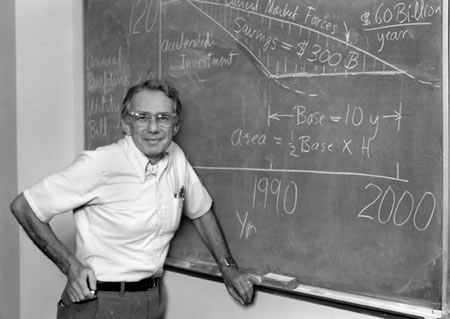 Art Rosenfeld at chalkboard in his Berkeley Lab office circa 1973
Art Rosenfeld at chalkboard in his Berkeley Lab office circa 1973
From that humble start, Art Rosenfeld helped pioneer a wide-ranging energy efficiency movement that has wrung a fortune in savings from a myriad of technologies that use, leak, or otherwise consume energy. Along the way, leading by example, he encouraged scores of scientists and scholars to make a difference in the world.
He got his day last month; two days actually. On April 27, the veteran Berkeley Lab and UC Berkeley scientist, and two-time appointee to the California Energy Commission, won the prestigious Enrico Fermi Award, the U.S. government’s oldest award for scientific achievement. The next day, he was feted by colleagues at a daylong UC Berkeley symposium in honor of his 80th birthday. Governor Schwarzenegger even proclaimed the day “Arthur Rosenfeld Energy Efficiency Day.”
“I’m pretty overwhelmed,” said Rosenfeld at the symposium on winning the Fermi Award.
But no one could have been surprised. In awarding Rosenfeld the Fermi Award, Secretary of Energy Samuel Bodman said that “Dr. Rosenfeld is one of the ‘founding fathers’ of energy efficiency, and the legacy of his research and policy work is an entire new energy efficiency sector of our economy, which now yields an astounding annual savings of around $100 billion, and growing.”
There are also the people he has inspired, an ever-expanding list that reads like a who’s who of energy research and altruism. Speaking at the symposium were Berkeley Lab Director Steve Chu, Ashok Gadgil and Mark Levine of the Environmen-tal Energy Technologies Division, UC Berkeley Chancellor Robert Birgeneau, and scientists from Stanford University, Princeton University, and the Natural Resources Defense Council, to name a few.
Rosenfeld’s promise was evident early in his career. He graduated from college with a degree in physics at age 18 and received his Ph.D. at the University of Chicago in 1954, serving as Nobel Laureate Enrico Fermi’s last graduate student. In 1955, he joined the physics group led by Nobel Laureate Luis Alvarez at UC Berkeley and Berkeley Lab. During the next 18 years, he was a key developer of the hydrogen bubble chambers used to detect particles at the Bevatron.
Then the 1973 Arab oil embargo hit. Rosenfeld knew very little about energy at the time, especially the supply side, but he knew from spending time in energy-conscious Europe that America had a lead foot when it came to energy demand. Something had to be done.
An autobiographical account published in the 1999 Annual Review of Energy and the Environment reveals his pragmatic approach to the problem. “At the office, late one Friday night in November 1973, I knew I’d have to wait in a half-hour line on Saturday to buy gasoline. I compared that with the equivalent gallons used by my office over the 60-hour weekend. My too-brightly-lit (1 kW!) office burned the equivalent of 5 gal/weekend of natural gas back at the power plant.”
He then hunted down and turned off each light switch on his 20-office floor, saving 100 gallons over the weekend. “I decided that UC Berkeley and its Radiation Labor-atory should do something about conservation.”
His work snowballed after that. In 1974, he organized a month-long workshop at Princeton University that was attended by experts on energy, transportation, and building design. In 1975, he established the Center for Building Science at Berkeley Lab, where a broad range of energy efficiency technologies were developed, including compact fluorescent lamps and “smart windows” that block heat from entering in the summer and escaping in the winter.
Today, his zeal to root out energy inefficiencies in every nook and cranny has led to advances in appliances, windows, lighting, roofs, building design, computers, greenhouse gas emission reductions, thermal distribution systems, and energy use analysis. He credits his success in part to timing and location.
“If my career had a big piece of good luck in it, it was getting started around 1973 at the time of the embargo,” he said at the symposium. “What has been quite wonderful has been the Northern California triangle. The Berkeley campus and Lawrence Berkeley Lab were very lucky that they were 15 miles from the Public Utilities Commission, which took this all seriously, and 70 miles from Sacramento, which took all this seriously.”
Rosenfeld didn’t limit his focus to California, however, or even the U.S. “Art is the only person I know of at LBL to beat me to China,” said Mark Levine, director of the Environ-mental Energy Technologies Division and a pioneer of promoting energy efficiency technologies in China. “He got there in ’84 and he helped set up our first exchange program. This is less well known. Art’s problem is that he has done so many great things that the lesser great things are forgotten.”
His legacy may grow much larger than he ever imagined, thanks to new initiatives at Berkeley Lab and other institutions. “Art started a great thing at the Lab in terms of doing something about the demand side of energy, and I think the Lab can also do a great deal on the supply side as well,” said Berkeley Lab Director Steve Chu, referring to the Lab’s multidisciplinary research on the conversion of solar energy into carbon-neutral forms of energy.
Ultimately, his greatest impact may be in inspiring other scientists. William Nazaroff, professor of environmental engineering at UC Berkeley, said that Rosenfeld is the rare “person who is willing to get out of the ivory tower and engage with the society where they are to make a difference — to be that scholar activist.”
ATLAS at Last: Bringing Baby to CERN
Early last Monday morning, in a well-rehearsed series of moves worthy of Mission Impossible, Maurice Garcia-Sciveres and Marian Zdrazil of the Physics Division maneuvered a high-impact black plastic case mounted on wheels through crowded security checkpoints at San Francisco International Airport, down the concourse to a gate where a Continental Airlines flight waited for boarding. Destination: Geneva, Switzerland, by way of Newark, NJ.
 Three disks crowded with detector modules form the pixel detector�s end-cap.
Three disks crowded with detector modules form the pixel detector�s end-cap.
One would have had to be familiar with the upscale baby market to recognize the suspension and wheels the mysterious black box rested upon: the stripped-down remains of an Inglesina baby carriage, advertised as having a “sporty-looking chassis for extreme conditions,” which even comes with its own air pump for reinflating its “all-terrain” tires.
It wasn’t the terrain Garcia-Sciveres and Zdrazil were concerned about. It was the delicacy of the unique device inside the box, a small but critical part of the giant ATLAS experiment at CERN.
Murdock Gilchriese, the physicist who has led Berkeley Lab’s work on the ATLAS pixel detector for the last decade, says it is “the most complex silicon tracking detector ever made.”
Inside the rolling black box was just one end-cap of the device, three disks crowded with detector modules. When finished, the detector will pack 80 million silicon pixels into a cylinder less than 5 feet long (1.4 meters) and only 1 foot, 7 inches in diameter (0.5 meter). The modules will record tracks of debris in three dimensions from a billion proton-proton collision events every second in CERN’s Large Hadron Collider, from which 100 per second will be selected for analysis.
“We knew we had to hand-carry the end-cap, and that getting it through security might be awkward,” says Gilchriese. “There’s no direct flight to Geneva from the Bay Area. Only Continental changes planes in the U.S., so we only have to go through security once.”
Garcia-Sciveres says, “We took the empty case to SFO and worked with the Transportation Security Administration and Continental. We rehearsed going through security and went aboard an aircraft of the same type. They actually seemed to be used to this kind of thing.”
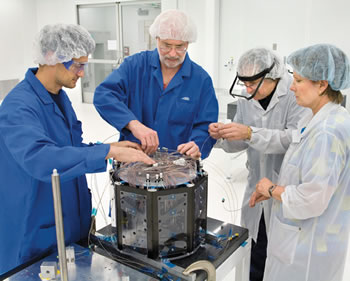 Maurice Garcia-Sciveres, Murdock Gilchriese, Mario Cepeda, and Rhonda Witharm work with the end-cap in the clean room. Many other technicians contributed to the pixel detector assembly, including Rodney Post, Co Tran, Tom Weber, Cheryl Weldon, Jon Wirth, and Jacqueline Wyckoff.
Maurice Garcia-Sciveres, Murdock Gilchriese, Mario Cepeda, and Rhonda Witharm work with the end-cap in the clean room. Many other technicians contributed to the pixel detector assembly, including Rodney Post, Co Tran, Tom Weber, Cheryl Weldon, Jon Wirth, and Jacqueline Wyckoff.
The scientists first checked out tourist class, but the case wouldn’t fit in the seats, so on Monday Garcia-Sciveres and the end-cap rode side by side in business class; postdoc Zdrazil was on his own, farther back in the plane. Using the folding wheels and suspension, they changed gates in Newark without having to take the “baby” through security again, and they were met in Geneva by CERN staff with the paperwork needed to get through customs.
When the LHC begins operating in the fall of 2007 it will be the first accelerator capable of systematically exploring the new physics of the “TeV scale,” trillion-electron-volt energies expected to reveal Higgs bosons, supersymmetric particles, and perhaps such esoterica as the constituents of dark matter, miniature black holes, and extra dimensions of space.
ATLAS is central to the enterprise. The giant experiment, now under construction, rises five stories high lying on its side; it consists of huge magnets and several kinds of detectors wrapped around the beam pipe where protons will collide with protons at energies up to 14 trillion electron volts.
The pixel detector is the innermost ATLAS detector and the one closest to the action. More than 100 scientists and engineers in six countries have worked to build it, but Berkeley Lab physicists and engineers have spearheaded most aspects of development since the beginning, everything from new kinds of detector modules to the carbon-fiber support structure.
 Garcia-Sciveres with the modified baby carriage and carrying case.
Garcia-Sciveres with the modified baby carriage and carrying case.
Each module is a rectangular tile a little over 2 square inches (14 cm2) in area, packed with 16 detector chips, a control chip, and circuitry, totaling 46,080 pixel elements — over 2.2 million on each disk, where 24 modules on one side are overlapped by 24 more on the opposite side. They must stand up to the LHC’s fierce radiation for 10 years, all the while providing high resolution of the particles that pass through them and retaining the information for several microseconds while computers decide whether the event is worth study.
The electronics generate intense heat. To cool the disks, liquid fluorocarbon flows through capillaries under 12 atmospheres of pressure, then expands into tubes that weave through the disks, dropping in temperature to minus 25 degrees C. “C3F8 is good at dissolving things,” says Gilchriese, so all the fittings are aluminum, specially bonded in extremely dry conditions to avoid the possibility that electrolysis could erode the joins and cause leaks.
“There will be tens of kilometers of wire in the finished pixel detector,” Gilchriese says, “and almost all the connections have to be soldered by hand. Plus the wires have to go through the detector support structure to get outside, and there’s not enough room for the bundles, so each wire has to be soldered to a printed circuit board to get through the structure and then soldered again on the other side.”
Before the trip to Geneva the disks were assembled in the clean room in Bldg. 77, resting on a black marble slab in the middle of the big white room like a scene from 2001: A Space Odyssey. In the innermost heart of ATLAS there’s a lot less space. But much of the most important science to come out of the Large Hadron Collider in the next years will be due to this diminutive yet extraordinary device.
Physicists Make the Case for Particle Colliders
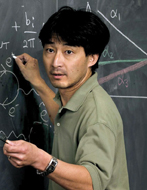 Hitoshi Murayama, Physics Division, as featured in Quantum Universe.
Hitoshi Murayama, Physics Division, as featured in Quantum Universe.
Everything you wanted to know about terascale physics but were afraid — or did not know what — to ask, can probably be found within the pages of a new report put out by the High Energy Physics Advisory Panel (HEPAP), the group of physicists that advises both the U.S. Department of Energy’s Office of Science and the National Science Foundation. Discovering the Quantum Universe: The Role of Particle Colliders, is a 44-page illustrated document, available as an internet download or free-of-charge publication, that provides a reader-friendly explanation of terascale physics and the next generation of particle accelerators designed to investigate it. The new report complements an earlier HEPAP report, Quantum Universe: The Revolution in 21st Century Physics, which was released in 2004.
James Siegrist, director of Berkeley Lab’s Physics Division, served as co-chair of the HEPAP committee that produced the new publication and a companion web site. Hitoshi Murayama of the Physics Division served on the committee and made substantial content contributions. The charge to the committee was to convey the excitement of 21st-century particle physics to audiences who are not science experts. The task was a challenge.
“Finding a good way of communicating particle physics to a general audience is hard,” said Murayama. “Working on this report, and with the original Quantum Universe report, provided an excellent learning experience for me.”
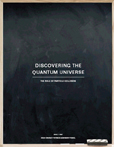 Cover of the new report.
Cover of the new report.
Perhaps the first question asked by many readers would be: What is terascale physics? This domain encompasses phenomena that should be observable when subatomic particles are accelerated to teravolt energies. Such phenomena include the Higgs boson, or whatever gives mass to particles of matter, and dark matter, the mysterious stuff that outweighs visible matter in the universe five to one. Terascale physics may also reveal extra dimensions of space, “superpartners” for all the familiar particles of matter, the existence of parallel universes, and maybe things no one has even thought to look for.
In charting the terascale territory and what physicists hope to find there, Discovering the Quantum Universe provides nine different “discovery scenarios.” It also introduces readers to the principal terascale discovery tools, the Large Hadron Collider (LHC), a proton collider now under construction in Europe, and the proposed International Linear Collider (ILC), which would accelerate and collide beams of electrons and their antimatter counterparts, positrons.
“We hope to explain to the broad non-scientific community the need in particle physics for a second large particle accelerator in addition to the LHC,” said Siegrist. “We hope this report clarifies the science issues regarding the close relationship of the two accelerators, and supports the case for the necessary research and development for an ILC project.”
To read or order a copy of Discovering the Quantum Universe, visit the website at http://www. quantumuniversereport.org.
Snapshot: An inside look at one of the Lab�s many interesting employees�
Tammy Welcome
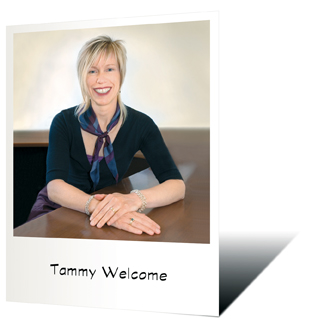
Name
Tammy Welcome
Job
IT Division Deputy
Childhood Ambition
Doctor
Weirdest Job
Owner of a hog operation
Guilty Pleasure
Attending art classes
Hero
My sister, Cheryl
Proudest Moment
Selling my first piece of jewelry
Last Book Read
The Creative License by Danny Gregory
Current Tunes on iPod or CD Player
Zucchero & Co.
Favorite Movie(s)
In the last few years: Finding Nemo, Winged Migration, Memento
When Not Working
Creating (chainmail, jewelry, knitting, painting), playing with my African Grey parrot, working out and hiking
Ideal Vacation
Hiking in mountains or near the ocean, no people in sight, followed by a great dinner and bottle of wine
Science and Operations: The New Collaborators
There’s a cultural upheaval percolating in the committee structures of Berkeley Lab, one that threatens to reinvent the way science gets done around here. And that’s important if the Lab’s ambitious initiatives for the future are to be achieved.
Senior managers spent a lot of time discussing it at two day-long planning sessions in 2005. Lab Director Steve Chu called it “one of the root things we have to change” if the Lab is to be competitive in advancing science for society. The “it”: scientists and non-scientists working together and understanding each other.
Ali Belkacem has seen the good. When he came here as a scientist in high energy atomic physics in the Chemistry Division in 1989, the Bevalac and the Hilac dominated Lab research, and scientists and support staff focused on making those two work. “They were close,” he recalled. “Everyone knew everyone by name. They were united by a shared purpose.”
Then came expansion, multiple divisions and programs, and a broader Lab research portfolio. Life became more complex. The “overhead committee,” which had scientists and staff together defining level and type of services needed, disappeared. Ali says operations units started treating the scientists like “customers,” and scientists tended to complain and criticize operations people, who figured that scientists just didn’t “get it.” “They became disconnected, and the word ‘partnership’ was lost in the process,” he said.
Enter Steve Chu. He saw research labor and overhead costs trending upward, with program taxes increasing to pay for them. Unfavorable comparisons to campus costs raised the specter of scientists leaving the hill to find less costly accommodations. So his mantra over his first two years has been: get the costs as low as reasonably possible, and justify those that remain to the researchers who pay them.

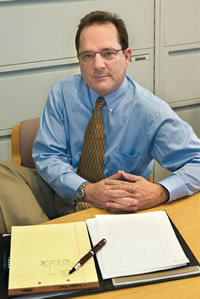 Ali Belkacem of Chemical Sciences (left) and Jeffrey Fernandez serve on the Cost Distribution Committee, commissioned by Director Steve Chu.
Ali Belkacem of Chemical Sciences (left) and Jeffrey Fernandez serve on the Cost Distribution Committee, commissioned by Director Steve Chu.
He commissioned something called the Cost Distribution Committee under Chief Financial Officer Jeffrey Fernandez, and Belkacem, senior scientist in Chemical Sciences, was among those called to serve with budget specialists. But the CDC had a bumpy start. “It was like shooting a ball back and forth,” Belkacem said, his English embellished with a native French-Algerian accent. “One side didn’t know what the other side wanted. We were running around like headless chickens. I wanted to get out.”
But he didn’t. “My son was doing a (high school) science project with different colored filters,” he recalled. “The only way to see white was to look through them together. We all look at things through different filters. But you need to converge together to see the light. I stayed (on the CDC) to convince my fellow scientists and budget people that this is worth doing.”
Call them the New Collaborators. Under the leadership of Fernandez and Belkacem, the CDC team is exploring ways to build a cost collection and distribution system that is less complicated, more transparent, and more responsive to the Lab’s strategic vision. Costs would be shifted in order to reduce the burden on labor. Taxes would be additive, not compounding, and scientists would have a better idea of the cost of a project. At least that’s the vision. So far, so good, according to Fernandez.
“With scientists’ involvement in this kind of policy analysis and decision-making, we deal with the two issues of input and credibility,” said the CFO. “If they are involved in the setting of overhead structures, the scope of support services offered, and priorities within the budget, it should also hopefully break down what some have seen as a two-class system at the Lab. It’s a real culture change.”
It won’t all be smooth. Outcomes may take some time, given the tradeoff nature of any solution reached. But it does illustrate a new healthy dialogue between researchers and those who support them.
It’s not just the CDC where this new collaboration is apparent. A recently launched Laboratory Support Advisory Council is meeting to discuss the level of services needed to achieve current and future Lab initiatives. A Compensation Committee in Human Resources features six leaders from scientific divisions and is working toward guiding principles for salary administration. The Information Technologies Advisory Council (formerly CSAC) has a positive track record for identifying computing needs.
“We’re all here to do science together,” Belkacem said. “It’s not just scientists doing science. It is a partnership. This is a special place, and it can be even better if we overcome our misunderstandings and work together. I think the Operations side has realized that it’s important to have scientists feel they are part of the decision-making in Operations. And scientists are accepting the roles and value of the support staff.”
As Director Chu stated at his strategic planning meeting last fall, “It is critical that we connect the science with the service. We are hunkering down. We don’t have the income we had before. So in order to be as efficient as we can, we must have Operations and science better teamed with the science end in mind.”
Behind the Science: Fab Shops Take on Technology
Can great scientific research exist without great scientific equipment? Ask any scientist on the Hill that question, and you’ll probably get a look, because they all know that scientific breakthroughs go hand-in-hand with cutting-edge equipment, much of it custom-made at the Lab by engineers and craftsmen in the Fabrication Shops.
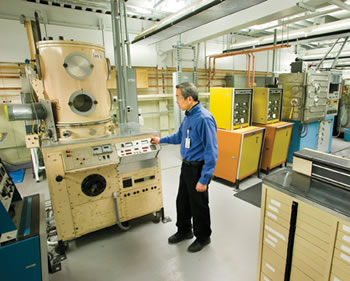 Daniel Lee checking vacuum system base pressure prior to thin film deposition.
Daniel Lee checking vacuum system base pressure prior to thin film deposition.
Their expertise runs the technical gamut from optics, vacuum coating, vacuum brazing, photofabrication, silk screening, nickel plating, and anodizing; to traditional machining, precision numerically controlled machining, electron discharge machining, welding, R&D sheet-metal work, specialty assembly, and metrology. Their accessibility and scientific experience make them the builders of choice for many researchers here.
Andy Wolski of the Accelerator and Fusion Research Division (AFRD), for example, relies on Daniel Lee, who heads the Vacuum Coating Shop, to produce multiple, precise test samples of materials with low secondary electron yield for his work on the International Linear Collider (ILC). “One of the problems we anticipate is the electron cloud instability. One way to kill this effect is to coat the inside of the [vacuum] chamber with a material that doesn’t release ‘secondaries’ when electrons hit it,” says Wolski.
Lee adapted a deposition process called magnetron sputtering to develop a technique capable of producing coatings on a large scale, a skill that will come in handy when it’s time to build the vacuum chamber for the ILC’s positron damping rings.
It’s not uncommon for the Fabrication Shops to capitalize on various technical disciplines to advance a project. Lee can turn to the Optics Shop headed by Rodney Post to clean or polish a material such as a glass ceramic composite before he vacuum-coats it with layers of chromium and gold films.
In addition, the Optics Shop polishes crystals and hard and soft metals to “finishes that are far beyond your average hubcap,” says Post.
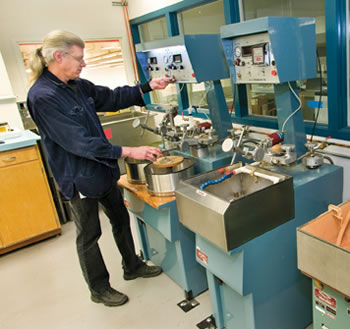 Rodney Post polishing a small quartz window in the optics shop
Rodney Post polishing a small quartz window in the optics shop
A versatile technician, Post has been working almost full-time on the ATLAS detector for the Large Hadron Collider, a particle accelerator that’s being built at CERN, the world’s largest particle physics center in Switzerland. Murdock Gilchriese of the Physics Division says Post is instrumental in the ATLAS project. In addition to helping assemble precision composite parts made of a carbon-fiber material similar to what is used in building airplanes, Post has “figured out how to construct and assemble custom heat exchangers used for the ATLAS pixel cooling system. Rodney played a very important role in making sure the parts fit together to meet very tight tolerances,” says Gilchriese.
In the Photofabrication and Silk Screening Shop, Rudy Bartolo can make customized parts on a very short notice for scientists such as Al McInturff, a senior physicist from AFRD. Bartolo has helped McInturff’s group on nearly all of the Lab’s high-field magnet programs. For magnets like the RD3B and D20, a set of world-record high-field devices, Bartolo made photoetchings for the protection heaters and voltage tap circuits.
“I can give Rudy a CAD drawing, and in return I get a working toy to put on a device,” says McInturff. “It’s just short of an art form to do that etching properly. And the fact that we can sit down with Rudy on site is invaluable to the unique demands of each project. Unlike the outside world, our production demands are not repetitive. Each etching is one or very few of a kind.”
The Engineering Division is taking several important steps to advance its services for both the present and long term. In addition to moving the specialty Fabrication Shops to Building 77, which also houses the Ultra-High Vacuum Cleaning (UHVC) and Plating Facility, the Division recently revived the Plating Shop.
Explains Al Harcourt, Supervisor of the UHVC and Plating Facility and the specialty shops, “We want to build for the future. Everything we’re doing is to make things better for the Lab.”
Theresa Duque is a technical writer-editor in the Creative Services Office.
The Greening of Berkeley Lab�In the Service of Society
A legacy of achievement
Energy Efficiency and Bevelac Beams
Andy Sessler became the Lab’s third director just two weeks after the start of the 1973 oil embargo, when gas prices soared and lines at gas stations snaked for several blocks. The energy crisis had begun.
 Andrew Sessler, Lab Director 1973-1980.
Andrew Sessler, Lab Director 1973-1980.
The 44-year-old theoretical physicist, an avid backpacker and skier who often rode a bike to work, a man of thought and action, was quick to respond. On his first day in office, Nov. 1, 1973, he established the Energy and Environment Division.
The launch of this program marked a turning point in the history of the Lab, which in the 1970s became known as Lawrence Berkeley Laboratory, or LBL for short. The Energy and Environment division joined the Lab’s accelerator, physics, and nuclear chemistry research, and its newer lineup of biology and medical research, and broadened the institution into a truly multidisciplinary operation.
It also meant that improving the world became just as important as understanding it. Sessler viewed the energy crisis and the world’s environmental problems as both a grand challenge for the Lab, and one of the reasons for its existence. In a letter to Lab staff dated the same day he became director, he said “No programs of the Laboratory are more important to its future than those in the fields of energy and environment.” He added that “the purpose and motivation for change at LBL is singular: to bring us closer to the goal that LBL be employed to its fullest in the service of society.”
But it wasn’t any easy road at first. In an Oct. 2, 1973, San Francisco Chronicle article, reporter Charles Petit shed light on what it was like to practice Lawrence’s trademark brand of Big Science in the early 1970s: “He [Sessler] will face problems alien to Lawrence and only lately familiar to [outgoing director] McMillan: a decline in public respect for science, sagging federal support for basic research, and a loss of morale among scientists themselves.”
The article also presaged the changes to come, pointing out that Sessler inherited “the beginnings of a diversification program, away from complete reliance on the big machines and abstract research and toward more ‘relevant’ concerns.”
“It’s the only way this place can stay alive,” Sessler is quoted in the article. “We have to change.”
This change, largely embodied by the Lab’s new focus on energy and environmental research, didn’t occur overnight, nor did it grow in a vacuum. Sessler recalled that it started with a memo he and Ken Watson wrote in 1968, which “called for scientists at the Lab to meet and discuss what could we do about the deterioration of the environment.”
Then-director Edwin McMillan embraced this work, and Nobel Laureate Glenn Seaborg gave Sessler and other initiators, Jack Hollander and Dick Mack, a suite of offices and a secretary. But funding remained scarce.
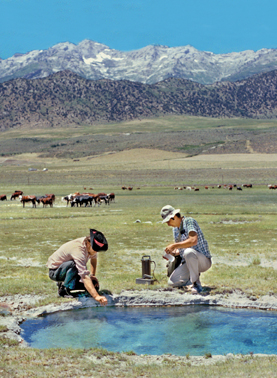 A hot geothermal pool in Ruby Valley, Nevada being analyzed by Lab scientists in a study of geothermal energy sources.
A hot geothermal pool in Ruby Valley, Nevada being analyzed by Lab scientists in a study of geothermal energy sources.
Then, two things occurred that allowed that initial memo to grow into a division. The Atomic Energy Commission (AEC), which funded the Lab, was thrust into the environmental research business when it was ordered to conduct environmental studies prior to the construction of nuclear power plants. And then in October 1973, Egypt attacked Israel, and an Arab oil embargo rattled the nation’s dependence on foreign energy.
Environmental stewardship also rose to the national stage during this time. Earth Day was first celebrated in 1970, confirming a commitment among thousands throughout the U.S. to protect “Spaceship Earth.” This sentiment was echoed in the halls of the federal government in the early 1970s, a period in which the Environmental Protection Agency was established, and the Clean Water and Endangered Species Acts were passed.
With this zeitgeist came federal funding, and the new division prospered. Under the guidance of Hollander, who served as its first director, 56 projects were underway by 1974.
“Those were good times,” recalled Sessler in a recent interview. “The U.S. was developing a national energy plan, and we were one of the few places in the country with the expertise to help.”
In its second year, the division began conservation and energy efficiency research, led by physicists Art Rosenfeld and Sam Berman. Among other accomplishments, Rosenfeld established the Lab’s Center for Building Science in 1975, where a broad range of energy efficiency technologies have been developed, including compact fluorescent lamps and “smart windows” that block heat from entering during the summer or escaping in the winter.
Today, it’s easy to defend the merits of steering Berkeley Lab toward energy and environment research. But not everyone welcomed this new tack in the beginning. Looking back in 1993, Bob Budnitz, the second division director from 1975 to 1978, recalled the skepticism the division faced: “There were many, many people here who felt that what we were doing wasn’t physics and it wasn’t engineering and we shouldn’t be doing it.”
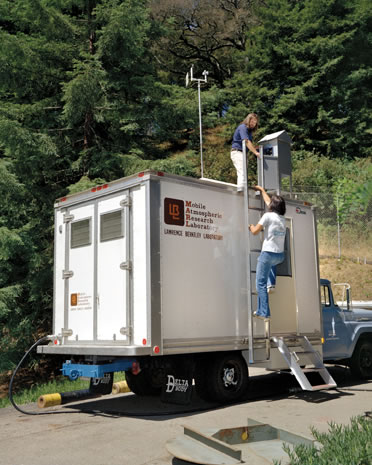 A mobile atmospheric research lab, operated by Craig Hollowell and Greg Traynor, part of the Lab's air-pollution research program.
A mobile atmospheric research lab, operated by Craig Hollowell and Greg Traynor, part of the Lab's air-pollution research program.
Even the AEC balked. After Rosenfeld published several papers that stressed the importance of conservation rather than energy production, AEC officials asked to review all Lab reports prior to publication. Sessler refused to comply, and backed by University of California President Charles Hitch, successfully fought the request. “We’re a science institution, and we needed to be free to publish what we wanted,” recalled Sessler.
Thanks in part to this doggedness, Berkeley Lab’s research portfolio was forever changed. From 1973 to 1980, applied science at the Lab grew to become equal in size to basic research, while basic research maintained a constant level. Today, Berkeley Lab is synonymous with energy-efficient appliance standards, innovative lighting technologies, pioneering atmospheric aerosol and indoor air quality studies, energy use analyses, and better batteries and cleaner combustion technologies.
The boom in applied science also yielded new divisions. In 1977, the Energy and Environment Division (later renamed to today’s Environmental Energy Technologies Division) was split into two, one for energy and environment research and one for Earth Sciences, where scientists tackled seismic research, geothermal energy and the disposal of nuclear wastes. Also in 1977, the Lab’s fusion energy research activities were incorporated into today’s Accelerator and Fusion Research Division.
Like the bumper sticker says, Lab scientists also acted locally. In the 1970s, Lab engineers and computer scientists helped develop and install an improved scheduling system that allowed Bay Area Rapid Transit trains to run more efficiently.
As Berkeley Lab retooled itself to address the nation’s energy problems, so did the federal government. In 1975, the Atomic Energy Commission slipped into history when President Ford signed a measure to form the Energy Research and Development Agency, which began oversight of Berkeley Lab and all AEC Labs. This agency, in turn, changed three years later, when President Carter established the Department of Energy.
Despite Berkeley Lab’s newly minted role as a leader in energy and conservation research, it remained a heavy hitter in physics and other basic research. As Sessler stated in a 1973 memo to Lab staff, “If LBL is to remain the unique national asset that it has been, it must, while executing socially significant research programs, maintain its strong fundamental research base.”
 The SuperHilac, successor to the HILAC.
The SuperHilac, successor to the HILAC.
In this vein, the 1970s saw the creation of the super-heavy ion linear accelerator, or SuperHILAC, which could accelerate ions as heavy as uranium. An upgraded version of an accelerator built in 1957, the SuperHILAC opened the door to the creation of synthetic elements beyond uranium, also known as transuranium elements. Seaborgium, one such element, was discovered in 1974 in an experiment conducted at Berkeley Lab by a team of researchers led by Lab physicist Albert Ghiorso and Lawrence Livermore National Lab’s Kenneth Hulet.
Lab physicists were also instrumental in the November 11, 1974, discovery of the J/psi particle at the Stanford Linear Accelerator Center (SLAC). This important discovery, which sparked a rapid change in high-energy physics, would eventually become known as the “November Revolution.” It also led to the construction of an even larger electron-positron collider, called PEP. This project, conducted jointly with SLAC, was one of the biggest undertakings at the Lab in the 1970s, and yielded the first new high-energy accelerator involving the Lab since the Bevatron of the early 1950s.
Also in 1974, Lab physicist Dave Nygren proposed the Time Projection Chamber, a revolutionary system for detecting subatomic particles that remains a mainstay of high-energy physics research at accelerators throughout the world.
And in 1975, the venerable Bevatron, which seemed to be nearing the end of its useful career in high-energy physics, was given a new lease on life by linking it to the SuperHILAC, a concept initiated by Ghiorso and carried out by Hermann Grunder. Nuclei began their journey in the SuperHILAC and then passed through a transfer line to the Bevatron, where they were accelerated to almost the speed of light.
Called the Bevalac, its beams were used to study high-energy nuclear reactions from heavy elements. This research field, christened at Berkeley Lab and led by Art Poskanzer, has spawned nuclear science experiments at Geneva’s CERN and Brookhaven National Lab. Its legacy can also be traced to the construction of the major accelerator at Brookhaven called the Relativistic Heavy Ion Collider.
 Pioneering research in the 1970s led to this PET scanner, shown with Thomas Budinger, Anna Hashima, and Judy Blair (1988).
Pioneering research in the 1970s led to this PET scanner, shown with Thomas Budinger, Anna Hashima, and Judy Blair (1988).
Bevalac beams were also found to be useful in the treatment of cancer and other diseases. This work was spearheaded in part by Cornelius Tobias’ research group, which took advantage of the fact that a heavy ion beam can destroy a tumor without seriously damaging surrounding tissue. In 1976, their investigations culminated in an intensive cancer treatment program in collaboration with physicians at the University of California, San Francisco.
In another medical development, Berkeley Lab scientists helped transform Lab scientist Hal Anger’s 1950s-era scintillation camera, which enables physicians to detect tumors using radioactive isotopes, into modern imaging systems. Gated heart single gamma tomography was developed in 1974, and dynamic, gated Positron Emission Tomography (PET) was developed in 1978. This work led to the highest resolution PET scanner in the world, the 2.6 millimeter-resolution camera, which was built by Berkeley Lab’s Thomas Budinger, Steve Derenzo and Ronald Huesman in 1986.
Berkeley Lab also acquired two large electron microscopes, led by Gareth Thomas, which helped cement the Lab as a leader in materials sciences. These machines have since given way to much more advanced microscopes at the Lab’s National Center for Electron Microscopy, which was established in 1983.
To foster innovative research, Sessler also started a Director’s Fund, which became the Laboratory Directed Research and Development Program. The fund enables the director to distribute funds from the overhead budget to select research projects. “We gave precedence to initiatives that looked interesting,” says Sessler.
 The Time Projection Chamber, shown with inventor David Nygren (left), was designated for use at the positron-electron colliding beam ring at Stanford.
The Time Projection Chamber, shown with inventor David Nygren (left), was designated for use at the positron-electron colliding beam ring at Stanford.
One of these “interesting” projects led to the 1979 discovery by Nobel Laureate Luis Alvarez that an asteroid impact killed the dinosaurs. Alvarez, working with his son, geologist Walter Alvarez, and nuclear chemists Isadore Perlman, Frank Asaro and Helen Michel, used neutron activation analysis to detect unusual amounts of iridium in Italian Cretaceous-Tertiary boundary sediments. Because iridium has a very low abundance on earth, they attributed the excess iridium to an impact from a 10-kilometer diameter asteroid.
Another Director’s Fund project helped make Hawaii’s Keck Telescope one of the most powerful in the world. At the heart of the telescope is a segmented mirror design that was proposed and developed by Lab astrophysicist Jerry Nelson.
The Lab’s research bonanza in both fundamental and applied science translated to growth. From 1973 to 1980, its budget increased from about $42 million to $142 million annually, and the number of employees jumped from about 2,000 to 3,000. In another sign the Lab had “arrived,” it became a stop on celebrity tours: the Dalai Lama and Prince Charles paid visits in the 1970s.
Several administrative changes were also made during Sessler’s term. He named Earl Hyde as the Lab’s first deputy director, instituted annual reviews for employees as well as term reviews for division directors. And to ensure the Lab would remain at the forefront of science, Sessler implemented annual external peer reviews for all divisions.
Sessler resigned the directorship on April 1, 1980, resuming a productive research career that lasts to this day. He left the front office knowing the Lab was well positioned to both address the nation’s energy problems and continue to probe the mysteries of the universe.
NEXT: The Rise of Advanced Materials
Berkeley Lab Science Roundup
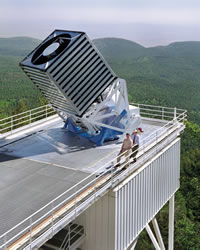 The 2.5 meter wide-field SDSS telescope was used to record thousands of individual galaxies and calculate their distances using both red shifts and color-distance relationships. The distribution of galaxies serves as a natural rule for measuring space.
The 2.5 meter wide-field SDSS telescope was used to record thousands of individual galaxies and calculate their distances using both red shifts and color-distance relationships. The distribution of galaxies serves as a natural rule for measuring space.
Biggest Ever 3-D Map of the Cosmos
A team of researchers led by David Schlegel, a Divisional Fellow in Berkeley Lab’s Physics Division, and Nikhil Padmanabhan, who will join the Physics Division this fall, has constructed the biggest ever three-dimensional map of the universe. Showing a wedge-shaped slice of the cosmos that spans a tenth of the northern sky, the new map encompasses 600,000 uniquely luminous red galaxies, and extends 5.6 billion light-years deep into space, equivalent to 40 percent of the way back in time to the Big Bang. The map was produced using the 2.5 meter Sloan Digital Sky Survey (SDSS) telescope in Apache Point, New Mexico, which can cover a field of view about six times the expanse of a full moon. Designed to help scientists better understand the distribution of matter in the universe, the new map makes it possible to measure structures as big as a billion light-years across. It shows that such large-scale structures are distributed the way current ideas about the accelerating expansion of the universe would suggest. The map’s assumed distribution of dark matter, which is invisible but still affected by gravity like ordinary matter, also conforms to current understanding.
The Secrets of WRN
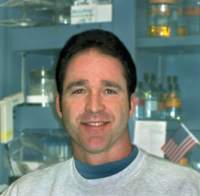 Steven Yannone of Life Sciences was one of the leaders of the effort to solve the structure of the WRN protein. The team also included LSD's John Tainer and Priscilla Cooper.
Steven Yannone of Life Sciences was one of the leaders of the effort to solve the structure of the WRN protein. The team also included LSD's John Tainer and Priscilla Cooper.
The crystal structure and molecular mechanisms of a key part of WRN, a protein that protects humans from premature aging and cancer, has been determined by a team of researchers from Berkeley Lab and the Scripps Research Institute. Steven Yannone of Berkeley Lab’s Life Sciences Division (LSD) was one of the leaders of this research effort that also included LSD’s John Tainer and Priscilla Cooper. They and their other collaborators were able to solve vital structural information about the WRN protein that revealed how it may function in specific DNA repair events. A defective WRN gene results in Werner’s syndrome, a rare inherited disease that shows no symptoms until puberty, when it begins to accelerate the aging process. By the time they reach their twenties, victims may become afflicted with cataracts, hair loss, wrinkled skin, osteoporosis, arteriosclerosis, and type II diabetes. Many patients contract cancer, and most die by the age of 50. Understanding how the WRN protein normally works to maintain genomic integrity could lead to new forms of treatment for cancer and age-related pathologies.
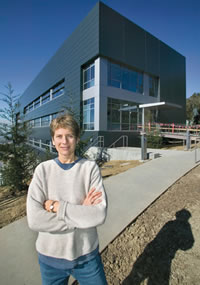 Carolyn Bertozzi was recently named Director of the Molecular Foundry. She is a chemist with the Materials Sciences and Physical Biosciences Divisions, a UC Berkeley professor, and an investigator with the Howard Hughes Medical Institute.
Carolyn Bertozzi was recently named Director of the Molecular Foundry. She is a chemist with the Materials Sciences and Physical Biosciences Divisions, a UC Berkeley professor, and an investigator with the Howard Hughes Medical Institute.
Possible Blood Test for Cancer
A chemical profiling technique that has potential for detecting the onset of cancer at the cellular level has been developed by Berkeley Lab researchers. A study led by Carolyn Bertozzi, a chemist whose appointments include Berkeley Lab’s Materials Sciences and Physical Biosciences Divisions, led the development of a technique for rapidly profiling O-linked glycoproteins in living animals. Changes in O-linked protein glycosylation — the attachment of sugars to proteins through an oxygen atom on the protein — are known to correlate with cancers and other diseases, such as inflammations and bacterial infections. Until now, however, scientists have lacked a practical means of monitoring such changes in a physiological setting. The technique developed by Bertozzi and her collaborators enables them to monitor changes that occur in the sugars that coat a cell’s surface or are released by the cell into the bloodstream. Comparing the sugars produced by cells that become cancerous with the sugars from normal cells could pave the way for creating a simple blood test that would diagnose a patient for cancer.
 Thomas Gutierrez, a theoretical physicist with the Nuclear Sciences Division, has proposed a thought experiment by which the question of whether neutrinos are their own antiparticle could be answered.
Thomas Gutierrez, a theoretical physicist with the Nuclear Sciences Division, has proposed a thought experiment by which the question of whether neutrinos are their own antiparticle could be answered.
Thinking About Neutrinos
One of the biggest questions about neutrinos, the phantomlike subatomic particles that have been the subject of intense study in recent years, is whether they are their own antiparticle. Thomas Gutierrez, a theoretical nuclear physicist doing postdoctoral research with Berkeley Lab’s Nuclear Science Division, has thought of one way to find the answer: two-particle intensity interferometry. In this technique, two detectors are used to measure the interference intensities of a single beam of particles. While it has been effectively used to reveal a variety of correlation and anti-correlation effects in the fields of particle physics and astronomy, two-particle interferometry is not sufficiently developed at this time for use with neutrinos. Nonetheless, Gutierrez is optimistic that his thought experiment could spark fresh ideas about future neutrino experiments.
-- Lynn Yarris
Three Berkeley Lab Scientists Elected To National Academy of Sciences
Three researchers affiliated with Berkeley Lab are among the 72 newly elected members of the National Academy of Sciences.
Membership in NAS is considered one of the nation’s highest honors for a scientist or engineer. Jillian Banfield, an earth scientist, Michael Marletta, a chemist, and David Patterson, a computer scientist, are Berkeley Lab’s three newest NAS members. All three also hold faculty appointments with the University of California at Berkeley. Their election to the Academy brings the total number of Berkeley Lab NAS members to 59.
 Jillian Banfield
Jillian Banfield
Banfield is a principal investigator in the Geochemistry Department of Berkeley Lab’s Earth Sciences Division, and a UC Berkeley professor in the Department of Earth and Planetary Sciences and in the Department of Environmental Science, Policy and Management. The Australian-born researcher is an authority on interactions between microorganisms and minerals, especially the impact of microorganisms on mineral weathering and crystal growth, biomineralization, and geochemical cycling. She is also a pioneer in the new scientific field called “nanogeoscience,” which investigates geological processes that involve particles no larger than 100 nanometers, and she leads a NASA-funded astrobiology study to determine whether life ever existed on the planet Mars.
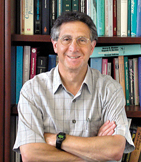 Michael Marletta
Michael Marletta
Marletta is a principal investigator with Berkeley Lab’s Physical Biosciences Division and UC Berkeley’s Aldo DeBenedictis Distinguished Professor of Chemistry, as well as a professor of biochemistry and molecular biology. He is also a faculty affiliate with QB3, the California Institute for Quantitative Biomedical Research, and is an elected member of the prestigious Institute of Medicine. His research for Berkeley Lab has focused on structure/function relationships in proteins, with a particular emphasis on the catalytic and biological properties of enzymes. His recent studies on how guanylate cyclase enzymes are able to selectively bind to nitric oxide or oxygen hold implications across a wide swatch of biology, including research into human cardiovascular diseases.
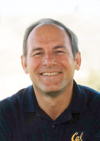 David Patterson
David Patterson
Patterson is a member of Berkeley Lab’s Computational Research Division and holder of the E.H. and M.E. Pardee Chair of Computer Science at UC Berkeley. He is also a member of the National Academy of Engineering. At Berkeley, Patterson led the design and implementation of RISC I, the first VLSI Reduced Instruction Set Computer, and he shared the 2000 IEEE von Neumann medal and IEEE’s 1999 Reynold Johnson Information Storage Award. He is currently building novel microprocessors using Intelligent DRAM for use in portable multimedia devices, and is a member of the ROC project, for Recovery Oriented Computing.
The NAS was established in 1863, under President Lincoln, as a private organization of scientists and engineers dedicated to “the furtherance of science and its use for the general welfare.” The Academy acts as an official adviser to the federal government, upon request, in any matter of science or technology. Total membership of NAS now stands at 2,013.
People, Awards, and Honors
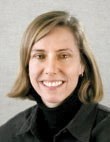 Mary Ann Piette
Mary Ann Piette
Commissioning Expert Receives Benner Award
Environmental Energy Technologies Division scientist Mary Ann Piette received a Benner Award at the National Conference on Building Commissioning. The award recognizes outstanding achievement in making building commissioning “business as usual.” She was honored for her paper on “Automated Demand Response Strategies and Commissioning Commercial Building Controls,” co-authored by David Watson, Naoya Motegi and Sila Kiliccote.
 Esmond Ng
Esmond Ng
Computing Experts Get SIAM Posts
Esmond Ng (pictured), leader of the Computational Research Division’s Scientific Computing Group, has been elected to a two-year term as vice chair of the SIAM Activity Group on Supercomputing. SIAM is the Society for Industrial and Applied Mathematics. Juan Meza, head of CRD’s High Performance Computing Research Department, has been appointed to SIAM’s Board of Trustees
 Christian Bauer
Christian Bauer
Physicist Gets DOE Investigator Award
Christian Bauer, with the Lab’s Physics Division, is among the recipients of the Department of Energy Office of High Energy Physics “Outstanding Junior Investigator Award.” The award seeks to assist the development of the research programs of outstanding untenured high-energy physicists. Bauer’s research focuses on “developing model independent predictions of SM expectations needed to interpret experimental data, which is required to provide understanding of the underlying physics.”
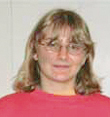 Gilly Elor
Gilly Elor
Berkeley Physics Major Receives Larimer Award
The second annual Ruth-Mary Larimer scholarship — an award of $500 — was given to UC Berkeley physics major Gilly Elor. A transfer student from Diablo Valley Community College, Elor was honored for her excellence in course work and research activities. She is also working on the KamLAND project at the Lab. Ruth-Mary Larimer was a long-time staff member of the Lab’s Nuclear Science Division.
 Edward Anderson
Edward Anderson
Purchasing Specialist Gets Training Award
Edward Anderson, with the Office of the Chief Financial Officer’s Procurement Department, recently received the Bill Gotcher award, bestowed by the National Association of Purchasing Management (Northern California). The award recognizes “outstanding students who reflect excellence in professional purchasing education.” Anderson used the Lab’s tuition reimbursement plan to complete a purchasing program at Cal State Hayward. His success in the classroom prompted the award.
 Ashok Gadgil
Ashok Gadgil
Gadgil Honored as ‘Modern-Day Leonardo’
Environmental Energy Techno-logies scientist Ashok Gadgil has been designated a “Modern-Day Leonardo” in conjunction with the Chicago Museum of Science and Industry’s new tribute to Leonardo da Vinci and his inventions. Gadgil was among 40 contemporary innovators chosen and featured as part of the exhibition.



(L-R): Stuart Freedman, David Patterson, George Oster
Three Researchers Elected to AAAS
Three Berkeley Lab scientists were elected to The American Academy of Arts and Sciences (AAAS). They include Stuart Freedman (left, Nuclear Sciences), David Patterson (middle, Computational Research Division, and George Oster (right, Physical Biosciences). Fellows and foreign honorary members are nominated and elected to the academy by current members.
Berkeley Lab View
Published once a month by the Communications Department for the employees and retirees of Berkeley Lab.
Reid Edwards, Public Affairs Department head
Ron Kolb, Communications Department head
EDITOR
Pamela Patterson, 486-4045, [email protected]
Associate editor
Lyn Hunter, 486-4698
STAFF WRITERS
Dan Krotz, 486-4019
Paul Preuss, 486-6249
Lynn Yarris, 486-5375
CONTRIBUTING WRITERS
Jon Bashor, 486-5849
Allan Chen, 486-4210
David Gilbert, (925) 296-5643
DESIGN
Caitlin Youngquist, 486-4020
Creative Services Office
PHOTOGRAPHY
Roy Kaltschmidt, 486-5731
Creative Services Office
Berkeley Lab
Communications Department
MS 65, One Cyclotron Road, Berkeley CA 94720
(510) 486-5771
Fax: (510) 486-6641
Berkeley Lab is managed by the University of California for the U.S. Department of Energy.
Online Version
The full text and photographs of each edition of The View, as well as the Currents archive going back to 1994, are published online on the Berkeley Lab website under “Publications” in the A-Z Index. The site allows users to do searches of past articles.
Flea Market is now online at www.lbl.gov/fleamarket
In Memoriam
Rowland Cannon
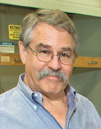 Rowland Cannon
Rowland Cannon
Rowland Cannon, a researcher in Berkeley Lab’s Materials Science Division and one of the best known ceramists in the world, died unexpectedly on April 21. He was 63 years old. Born in Idaho Falls, Idaho, Cannon completed his undergraduate and graduate studies in the Department of Materials Science and Engineering at the Massachusetts Institute of Technology. He enjoyed a long and successful career in ceramic science, beginning as an Assistant and Associate Professor at MIT (1975-1982), and since 1983 serving as a Research Engineer, Lecturer, and Staff Scientist at UC Berkeley and at Berkeley Lab. Throughout his career, he engendered respect, trust and affection from a wide network of colleagues and collaborators in the U.S., Asia and across the globe, particularly as a frequent visiting scientist at the Max-Planck Institute in Stuttgart, Germany. His work was rewarded with numerous honors, including the American Ceramic Society’s award for paper of the year (1991), being named an ACS Fellow (1994), earning a Humboldt foundation research award (1999-2000), and most recently completing a month-long W. D. Kingery Distinguished Lectureship at MIT in February-March 2006. Throughout his career, he was known for his profound understanding and insight into the mechanical behavior and microstructure evolution in ceramics. Based on this work, he published over 140 scientific papers and gave a remarkable 11 invited Gordon Conference lectures. He is survived by his children, Hilary, Ethan and Zachary, his brother Douglas and sister Maurine, and his father.